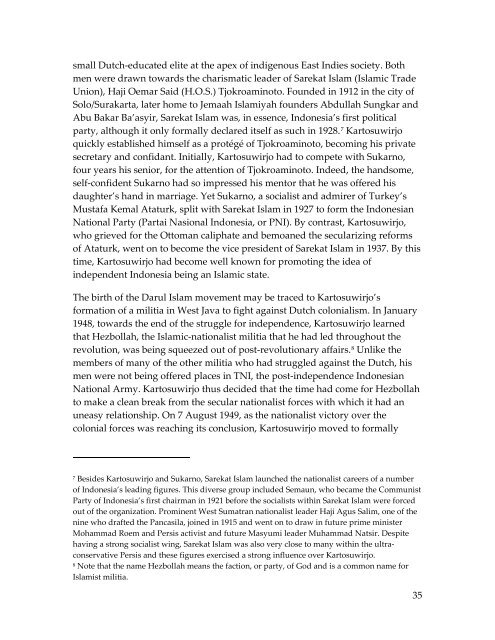Create successful ePaper yourself
Turn your PDF publications into a flip-book with our unique Google optimized e-Paper software.
small Dutch-educated elite at the apex of indigenous East Indies society. Both<br />
men were drawn towards the charismatic leader of Sarekat Islam (Islamic Trade<br />
Union), Haji Oemar Said (H.O.S.) Tjokroaminoto. Founded in 1912 in the city of<br />
Solo/Surakarta, later home to Jemaah Islamiyah founders Abdullah Sungkar and<br />
Abu Bakar Ba’asyir, Sarekat Islam was, in essence, Indonesia’s first political<br />
party, although it only formally declared itself as such in 1928. 7 Kartosuwirjo<br />
quickly established himself as a protégé of Tjokroaminoto, becoming his private<br />
secretary and confidant. Initially, Kartosuwirjo had to compete with Sukarno,<br />
four years his senior, for the attention of Tjokroaminoto. Indeed, the handsome,<br />
self-confident Sukarno had so impressed his mentor that he was offered his<br />
daughter’s hand in marriage. Yet Sukarno, a socialist and admirer of Turkey’s<br />
Mustafa Kemal Ataturk, split with Sarekat Islam in 1927 to form the Indonesian<br />
National Party (Partai Nasional Indonesia, or PNI). By contrast, Kartosuwirjo,<br />
who grieved for the Ottoman caliphate and bemoaned the secularizing reforms<br />
of Ataturk, went on to become the vice president of Sarekat Islam in 1937. By this<br />
time, Kartosuwirjo had become well known for promoting the idea of<br />
independent Indonesia being an Islamic state.<br />
The birth of the Darul Islam movement may be traced to Kartosuwirjo’s<br />
formation of a militia in West Java to fight against Dutch colonialism. In January<br />
1948, towards the end of the struggle for independence, Kartosuwirjo learned<br />
that Hezbollah, the Islamic-nationalist militia that he had led throughout the<br />
revolution, was being squeezed out of post-revolutionary affairs.<br />
8<br />
Unlike the<br />
members of many of the other militia who had struggled against the Dutch, his<br />
men were not being offered places in TNI, the post-independence Indonesian<br />
National Army. Kartosuwirjo thus decided that the time had come for Hezbollah<br />
to make a clean break from the secular nationalist forces with which it had an<br />
uneasy relationship. On 7 August 1949, as the nationalist victory over the<br />
colonial forces was reaching its conclusion, Kartosuwirjo moved to formally<br />
7<br />
Besides Kartosuwirjo and Sukarno, Sarekat Islam launched the nationalist careers of a number<br />
of Indonesia’s leading figures. This diverse group included Semaun, who became the Communist<br />
Party of Indonesia’s first chairman in 1921 before the socialists within Sarekat Islam were forced<br />
out of the organization. Prominent West Sumatran nationalist leader Haji Agus Salim, one of the<br />
nine who drafted the Pancasila, joined in 1915 and went on to draw in future prime minister<br />
Mohammad Roem and Persis activist and future Masyumi leader Muhammad Natsir. Despite<br />
having a strong socialist wing, Sarekat Islam was also very close to many within the ultraconservative<br />
Persis and these figures exercised a strong influence over Kartosuwirjo.<br />
8<br />
Note that the name Hezbollah means the faction, or party, of God and is a common name for<br />
Islamist militia.<br />
35


